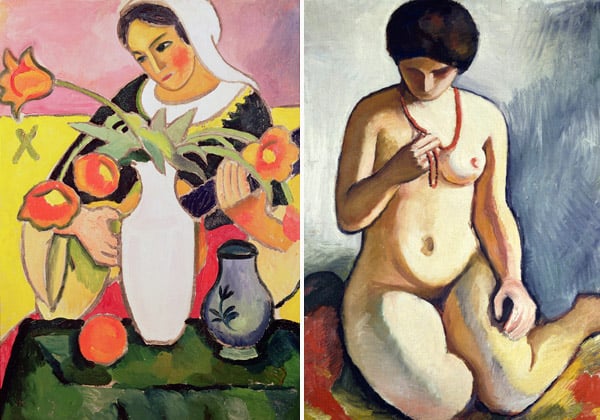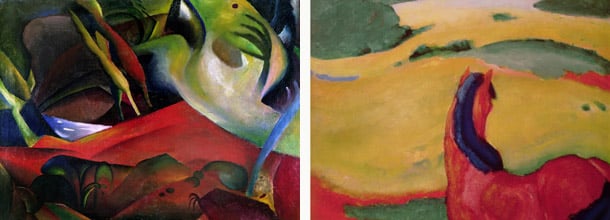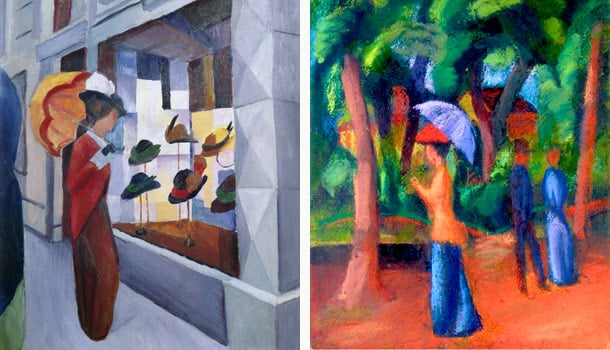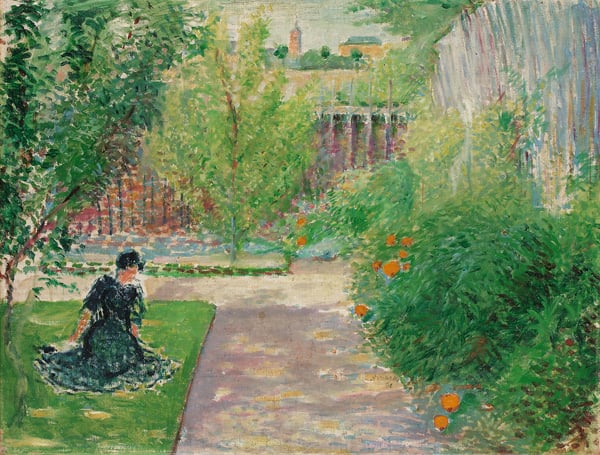
Artist Spotlight: The short colourful life of August Macke
German Expressionist artist August Macke (1887-1914) rewrote the course of German art as one of the founding members of Der Blaue Reiter. Best known for his dramatic use of colour, his ground-breaking use of cubist technique brought the traditional Impressionist subjects of domestic life, landscapes and nudes into the 20th century.
“The most important thing for me is the direct observation of nature in its light-filled existence.”
– August Macke
First Impressions in Paris, 1907
Born in Germany on 3 January 1887, August Macke studied at the Dusseldorf Art Academy and the School of Applied Art between 1904 and 1906. A year later, he made his first visit to Paris, where he discovered the works of the Impressionist artists. Their subtle dappling technique and domestic subject had a clear inspiration on his painting ‘Sunny Garden’, 1908.
Upon returning to Germany, Macke began to study under the prominent German Impressionist painter Lovis Corinth, but clashed with his tutor and ultimately found Impressionism inexpressive.
Matisse and Fauvism, 1909
On a later trip to Paris, Macke came across the works of Henri Matisse and the Fauvist group. The Fauves emphasised strong colour over realistic representation as a backlash against Impressionism.
Inspired by their ideology, Macke began to use brighter colours, a flattened perspective and broader, looser brushstrokes.

Left: The Lute Player, 1910 (oil on canvas) by August Macke, Musee National d’Art Moderne, Centre Pompidou, Paris
Right:Nude with coral necklace, 1910, by August Macke / De Agostini Picture Library / M. Carrieri
Der Blaue Reiter, 1911-14
Also in 1909, Macke met the German Expressionist painter Franz Marc in Munich. Along with a number of local German and Russian immigrant artists, including Wassily Kandinsky, they formed the Der Blaue Reiter (‘Blue Rider’) group in 1911. Though they lacked an official artistic manifesto, the group shared a common interest in abstract prismatic colours, spirituality and a rejection of contemporary materialism.

Left: The Storm, 1911 (oil on canvas) by August Macke
Right: Horse in a landscape, 1910 by Franz Marc
Each member within Der Blaue Reiter was free to develop their own style but the influence of the fellow artists on Macke’s paintings is evident. His ‘The Storm’, painted in 1911, used a similar colour scheme to Marc’s ‘Horse in a Landscape’, completed the previous year.
Macke’s work gradually developed a cubist approach, influenced by the French artist Robert Delaunay and Swiss-German artist Paul Klee, who was loosely associated with the group.

Left: Park with pond, 1913, by August Macke, Sprengel Museum Hannover / De Agostini Picture Library / M. Carrieri
Right: Three Women at the Table by the Lamp, 1912 (oil on canvas), August Macke
World War One, 1914
Der Bleu Reiter were disbanded with the outbreak of the First World War in August 1914. Both Macke and Marc were enlisted in the German army and the Russian immigrants were deported back home. Most of Macke’s last paintings, however, remained focused on domestic scenes of shopping, promenades and a life of leisure, showing no signs of the devastating war to come.

Left: The Milliner’s Shop, 1914 by August Macke, Museum Folkwang, Essen, Germany
Right: Walking in the Park, 1914 (gouache, w/c & pastel on paper), Macke, Augus
Macke was killed in battle on 26 September 1914 in Champagne, France, aged just 27. His paintings are now held in museums and collections around the world, including the dedicated August Macke Haus museum in Bonn, Germany, where he once lived.
Find out more
August Macke – see all images in the Bridgeman Archive
All images in this article are sourced from the Bridgeman website. Contact their sales team on uksales@bridgemanimages.com for more information regarding licensing, reproduction and copyright issues.


